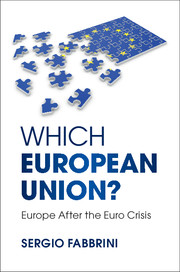Book contents
- Frontmatter
- Dedication
- Contents
- List of boxes
- List of figures
- List of tables
- List of abbreviations
- Preface – How many unions?
- Acknowledgments
- Part I Institutionalization of multiple unions
- 1 From Rome to the Lisbon Treaty
- 2 The Lisbon Treaty and the euro crisis
- 3 Institutionalization and constitutional divisions
- Part II Main perspectives on the European Union
- Part III Towards the compound union perspective
- Appendix
- Glossary
- References
- Index
2 - The Lisbon Treaty and the euro crisis
Published online by Cambridge University Press: 05 March 2015
- Frontmatter
- Dedication
- Contents
- List of boxes
- List of figures
- List of tables
- List of abbreviations
- Preface – How many unions?
- Acknowledgments
- Part I Institutionalization of multiple unions
- 1 From Rome to the Lisbon Treaty
- 2 The Lisbon Treaty and the euro crisis
- 3 Institutionalization and constitutional divisions
- Part II Main perspectives on the European Union
- Part III Towards the compound union perspective
- Appendix
- Glossary
- References
- Index
Summary
Introduction
The Lisbon Treaty came into force on December 1, 2009. The last member state to endorse it, Ireland, which first rejected it in a popular referendum held on June 12, 2008, finally approved the new Treaty in a second popular referendum held on October 2, 2009. The Lisbon Treaty consists of a series of amendments to the Treaty on European Union (TEU, Maastricht 1992) and the Treaty Establishing the European Community (TEC, Rome 1957), the latter being renamed the Treaty on the Functioning of the European Union (TFEU) in the process. The Charter of Fundamental Rights, elaborated for the Nice Treaty of 2001, has been given legal value as a third treaty included in the Lisbon Treaty. The two consolidated Treaties and the Charter form the legal basis of the Union. The Lisbon Treaty has tried to impose order on the institutional complexity acquired by the EU, giving a legal personality to the latter when acting in international affairs and abolishing the three pillar structure (Devuyst 2012). Notwithstanding the formal suppression of the pillar structure, the Lisbon Treaty did, however, recognize the existence of two different decision-making regimes (one supranational and the other intergovernmental).
This chapter is organized as follows. First, it will discuss the differentiation between the two decision-making regimes, here conceptualized as the dual constitution of the Lisbon Treaty. After analysis of the supranational constitution, it puts forward a detailed analysis of the intergovernmental constitution, regarding both foreign policy and economic policy decision-making regimes. Here I use the concept of “constitution” in a “material” sense (see Chapter 3) as a decision-making regime supported or justified by a distinct principle of power distribution. If the supranational constitution sustains and justifies a system of government characterized by the sharing of decision-making power among four institutions (the dual executive constituted by the European Council – recognized as a formal institution of the Union for the first time – and the Commission and the bicameral legislative branch constituted by the EP and the Council), the intergovernmental constitution instead sustains and justifies a system of governance, characterized by the pooling of decision-making power in two institutions, the European Council and the Council, representing the national governments of the Union's member states.
- Type
- Chapter
- Information
- Which European Union?Europe After the Euro Crisis, pp. 33 - 63Publisher: Cambridge University PressPrint publication year: 2015



